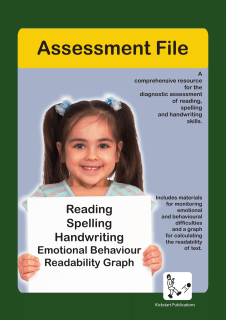|
KICKSTART ASSESSMENT FILE
Pupils take the Kickstart Skills Assessment to determine strengths and weaknesses in phonics, vocabulary, reading, spelling and handwriting. The Kickstart Assessment can be used to periodically monitor a pupil’s progress with objective measurement of achievement. The Kickstart Skills Assessment provides many advantages. Our approach to teaching and assessment focuses on the underlying causes of difficulty, not just the course work that a pupil is working on at the time. Kickstart materials support ‘Mastery Learning’ - an important teaching method to ensure that pupils retain information long after it is learned. THE KICKSTART ASSESSMENT FILE Assessment Procedures
PHONIC SKILLS ASSESSMENT
Ten pages provide a test for the acquisition of phonic skills. The tests are presented in a hierarchical order and it is recommended that the tests are used in the order presented until the pupil starts to make errors. When using the first sheet of the phonic skills test, say ‘I am going to point to some letters. When I point to one tell me the sound it makes.’ If the pupil gives the letter name say ‘Yes, that is what it is called but what sound does it make?’ When working on subsequent sheets say ‘I am going to point to some words, when I point to a word I want you to read it. If it is hard to read have a go.’ Stop testing when the pupil starts to experience difficulty. Make a note if the pupil has to blend a word rather than reading it without hesitation. The record sheets provide a space for the teacher / parent to record the pupil’s responses where errors are made. It is often helpful to record incorrect responses so that specific errors can be identified e.g. ‘b’ – ‘d’ or ‘e’ – ‘i’ confusion. Once the pupil reaches a level where errors are made, a teaching programme can be arranged. At the rear of the Assessment File there is a list of resources for work in specific areas. When consolidating a particular phonic skill it is often helpful to start with a specific letter pattern then generalise it to other patterns, e.g. bake cake fake lake make made male tale making taking The teacher / patent can then move on to further examples of ‘silent e’ using vowels ‘i’, ‘o’, ‘u’. COMMON WORDS - READING
Four pages provide a test for the reading of words identified as commonly used in children’s literature and reading schemes but without proper nouns. The words are not arranged in a hierarchical order but are arranged to match the resources addressing these words and in an order that allows the construction of phrases and sentences at an early stage. It is suggested that the pupil is tested from the beginning of the test until 10 errors are made. The 10 words can then be used as the basis of a teaching programme. Where possible the target words should be embedded in a meaningful sentence or phrase where the other words can be read by the pupil. A target word can also be used to teach a particular letter pattern by generalising it to a group of words, e.g. look hook shook book took The record sheet allows the teacher to record the pupil’s response when an error is made. This can be useful in identifying specific errors, e.g. ‘b’ – ‘d’ confusion. It is often advisable to retest some words recently mastered in order to check that learning has been permanent. Kickstart Assessment File |
NORMATIVE SPELLING TESTS
The Graded Spelling Test The Graded Spelling Test is a quick test for determining a normative score. The Spelling Ages are given as years and tenths of a year. When administering the test it is advisable to say the word, then a sentence embedding the word, then the word again, e.g. “Spell ‘lost’.” “I lost my pen and had to get a new on.” “Spell ‘lost’.” The test should be discontinued when the pupil has made a total of 10 errors. The score is obtained by counting all correct spellings to this point. The record sheet provides the opportunity to record the pupil’s responses when an error is made. The nature of incorrect responses can be helpful in diagnosing specific errors, e.g. ‘frend’ for ‘friend’ – indicates the need to teach the vowel digraph ‘ie’. When using spelling tests say ‘I am going to say some words. When I say a word I want you to write it down. If it is hard to write down listen to the sounds in the word and have a go. For each word, say the word then put it into the context of a sentence, then say the word again, e.g. “Write the word ‘over’.” “The boy jumped over the wall.” “Write the word ‘over’.” Stop testing when 10 errors are made. This will provide the start of a spelling programme. When correcting spellings consider;
LETTER STRING SPELLING TEST
The Letter String Spelling Test is used to diagnose specific spelling errors so that a programme can be devised. When administering the test it is advisable to say the word, then a sentence embedding the word, then the word again, e.g.: “Spell ‘cold’.” ‘It was very cold when it snowed.” ‘Spell ‘cold’.” It is often helpful to administer the complete test so that all errors can be identified. A programme can then be devised, teaching one string at a time. It is advisable to return to previously taught strings to check for permanent learning. Some pupils may become tired before the end of the test. With these pupils it may be advisable to administer the test in two halves with a significant interval between. COMMON WORDS SPELLING
The words used for this test differs from the list for reading although many words will occur in both lists. The words in the list for reading were identified from children’s literature. The words for spelling were identified after analysing 6000 words of Second Class free written work. Numbers, days of the week and months were added after removing all other proper nouns. It is suggested that the pupil is tested until 10 errors are made. The ten words can then form the basis of a spelling programme. Each spelling can be used to generate a list of words with the same pattern so that the individual spelling can be generalised to other words. It is not necessary for all the words in the list to rhyme as long as there is a common letter string, e.g.: Target word ‘come’ come some dome home HANDWRITING
The development of a fluent, legible handwriting style becomes increasingly important as the pupil progresses through the school and is an essential part of secondary education. The handwriting section of the Kickstart Assessment File helps to identify specific difficulties with handwriting and suggestions for overcoming them. It is generally accepted that handwriting faults should be corrected as soon as they become apparent as it can be very difficult to eradicate unwanted habits at a later stage. It is also generally accepted that the development of a joined script often eradicates difficulties, particularly those concerned with letter reversal and spacing. SOME STRATEGIES TO HELP POOR WRITERS A quick and legible handwriting style rarely comes naturally. Handwriting habits are established at an early age: these habits are often impossible to change and difficult to modify. However, modifications can often be made and quite minor adjustments can sometimes bring about desired results even if the style is not exactly textbook. The teacher or pupil may become frustrated with written tasks because of one or more of the following:
Where this is the case it may be worth examining the points below and the ‘Guide to Assessing Handwriting Problems’ to see if any modifications are appropriate.
|
|
|


